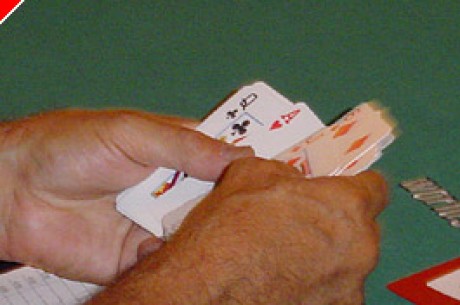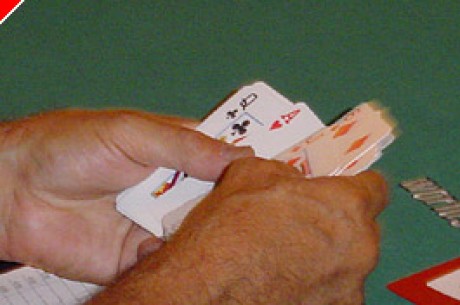Stud Poker Strategy - Fifth Street Shuffle

I like candlepin bowling. The bowling ball fits into the palm of my hand. The pins are long, tapered, and narrow. And I get three throws to knock down all the balls. What's not to like.
I'm not very good at it though. I have a problem that besets many 7-Card Stud players. Let me explain.
I'm great with the first ball. I rarely get a strike. But then strikes are rare in this game. I'm good at hitting the middle pins, so I usually leave only two or three standing after my initial ball is thrown down the lane.
My problem is with the second and third ball. I don't have a large target to aim at. And my aim is generally not very precise. Starting off, with a simple strategy of aiming toward the center, I'm excellent. But refining my swing - well that's tougher and my game suffers accordingly.
The same is often true of stud players. They know how to play on Third Street. And they do pretty well casting off unplayable hands in unplayable situations. But when the decisions become a bit more refined and difficult as the game progresses they falter.
If you find yourself starting off confident but then foundering around as the Streets progress, consider some simple rules of thumb to follow on those later Streets.
First of all, focus on your decisions on Fifth Street. That's the Street when the blinds typically increase - doubling those of Third and Fourth Street. That's the next critical moment for you to decide whether to play on or concede.
By Fifth Street, for the most part, you want to either be drawing to the best hand or have the best hand. Once you've decided on playing you are pretty much - though not completely - committed to playing Sixth and Seventh.
Here's an example of playing on.
On Third Street you started with (Ah7s)Ad. You raised. You got three callers. You would have preferred just one or two but you have three.
On Fourth Street you didn't get a second pair, no one paired his door card, and you see one player with two to a Flush. You should continue to bet your highest pair - and you do. Two players drop out. You're against the guy with the flush draw.
On Fifth Street you still don't improve. Neither, apparently, does your opponent, catching a non-suited upcard.
Some players make the horrible mistake of checking here. They figure, wrongly, that since they still only have a pair, that their hand isn't strong enough to justify a double bet.
They are wrong. You must continue to push that pair of Aces. True, you may be up against a higher hand. Your opponent might have caught two pair or even trips. But you must press your apparent advantage in this position to drive out an opponent who is much more likely to be drawing for a hand that will beat you. Even if you knew he had two pair, you would call his bet - having a sufficiently strong possibility of making a higher two pair to justify the chase (assuming all your cards and all his cards are live you have about a 40% chance of winning). So betting here, with the possibility that he will fold and award you the pot or call you when he is behind, is correct.
On the other hand, suppose you started with the same hand. You bet it the same way. You got called by a player with a Jack. On Fourth Street you don't improve, nor does he. You bet and he called. On Fifth Street you catch another blank but your opponent catches a Jack. He bets. What do you do.
Some players, figuring that they may well be up against a guy with only two pair - or even just the pair of Jacks, speculating that they still have a chance to get Aces up or Trip Aces, call the Fifth Street bet This is wrong. You should fold.
A paired door card is a serious danger sign - a stop sign. True, he may not have luckily leaped into the lead by hitting trip Jacks. But the chances are very strong that he did. If he did then you are very far behind indeed - having only about a 10% chance of winning the hand.. If he only hit two pair, with a buried pocket pair, then you are only a 60/40 dog as we've seen above. It's just not worth it. Give it up now and concede the pot.
Here are a few rules of thumb that can also aid you in making the right decisions in this case. These are general rules that have exceptions that I may get into in a future article.
1. Fold to a paired door card if you only have a pair.
2. Fold to what you presume is a higher pair if you have a lower pair
3. Fold your 3-Flushes and 3-Straights or inside straight draws
4. Call with your 4-Flushes if they are live (at least six remain unseen)
5. Call with your 4-Straights if you have a higher card than your opponent's pair, he doesn't appear to be on a Flush draw, and there are at least six straight cards remaining.
6. Call if you believe you have an overpair to your opponent's two pair.
7. Bet if you believe you have a higher hand than your opponent's hand.
Yes, sometimes you have to change your posture from offense to defense, leading to drawing, or even leading to folding. That's why it's called the Fifth Street shuffle. How you position yourself here will help you play the next two streets with greater balance and confidence.








